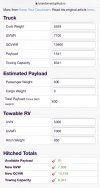Yep, it had to be fully loaded... This is the interesting thing I have been studying and was going to do a post on the SAE J2807 standard that dictates the numbers used. There are assumptions in the SAE standard that address the passengers and a hitch. So, for example, two passengers at 150 lbs and a 70 lb hitch and 10% tongue weight (based upon the total weight of the trailer) are "assumed" in the the rating.
What does this "really" mean when you "assume" these things in the standard?
So, my truck using the VIN look up from RAM says that I have a max payload of 1277 lbs. (Pretty loaded) Since payload is usually the limiting factor for towing, I am concentrating upon that part of the standard. So, on the surface, I can put 1277 lbs of "payload" in the truck. My assumption was that this included me and my wife and whatever the trailer tongue weighed. I am right at my limit with that.
BUT, if the assumptions are already plugged into the standard, does that mean that RAM figured my tow rating/payload AFTER the assumptions or before? I mean, IF the Standard "assumes" 370 lbs and 10% of the trailer, that implies that my payload is ON TOP of the assumptions. Right?
So, it is still not completely clear what the payload number means in my opinion. I hope someone can clear this up. Back in the day before the standard was accepted, there were pages in manuals that said things like... This tow and payload rating assume the there is a 150 lb driver in the car AND SO you could actually put the payload on the vehicle and IF it was 150 lbs over that was OK, because the 150 driver was "assumed" in the rating.
So, what is it? quit over thinking it for me? Go by what RAM says or otherwise. I think my original assumption of just accepting what the RAM site says is correct, but it is NOT clear... OH, for those people trying to do the math, this is the RAM website where you can find your specific truck tow ratings by VIN number
https://www.ramtrucks.com/towing/towing-guide.html
As noted, I wish someone could clear up the "assumptions" in the Standard and how they apply to the ratings on the website including other trucks.
 www.granddesignrv.com
www.granddesignrv.com














